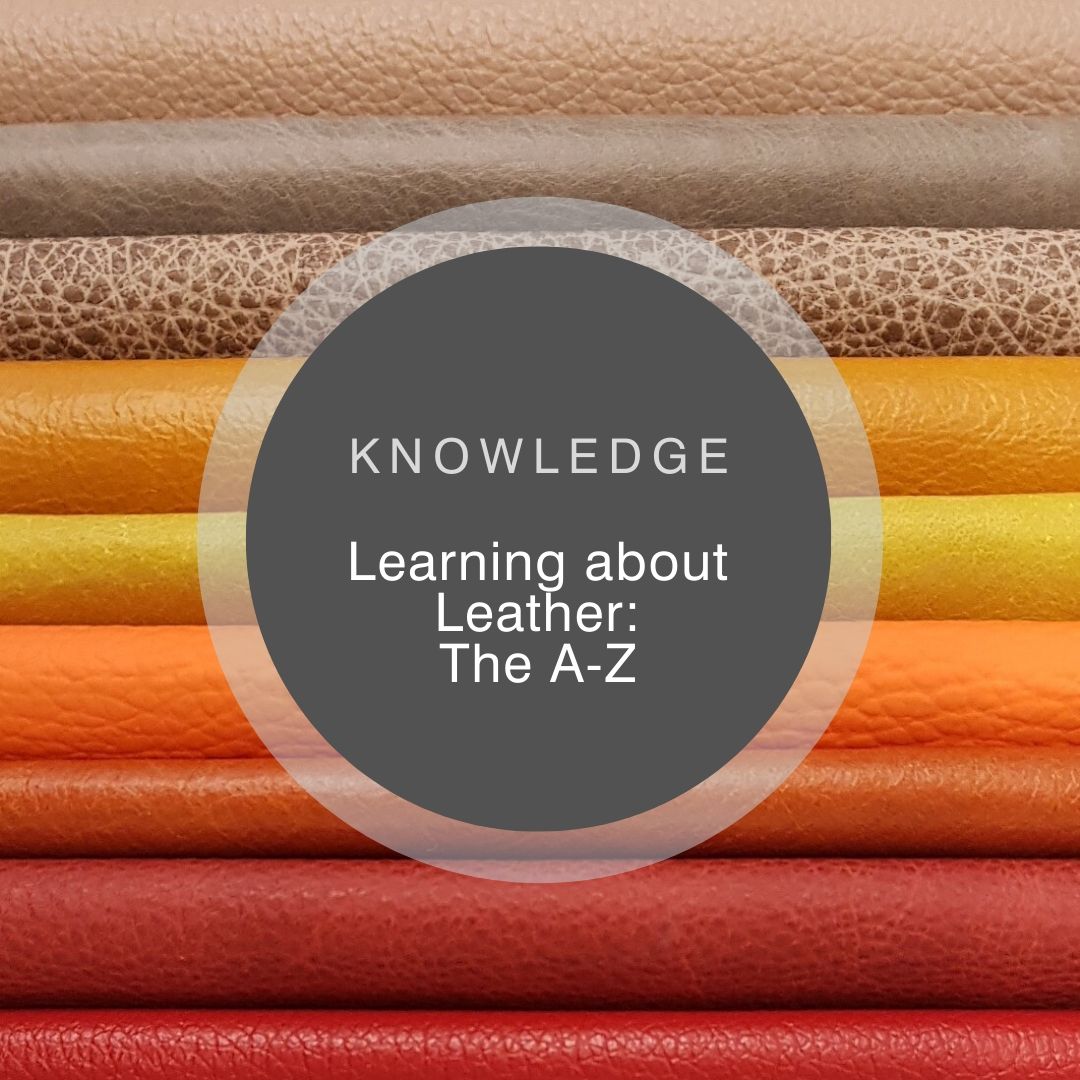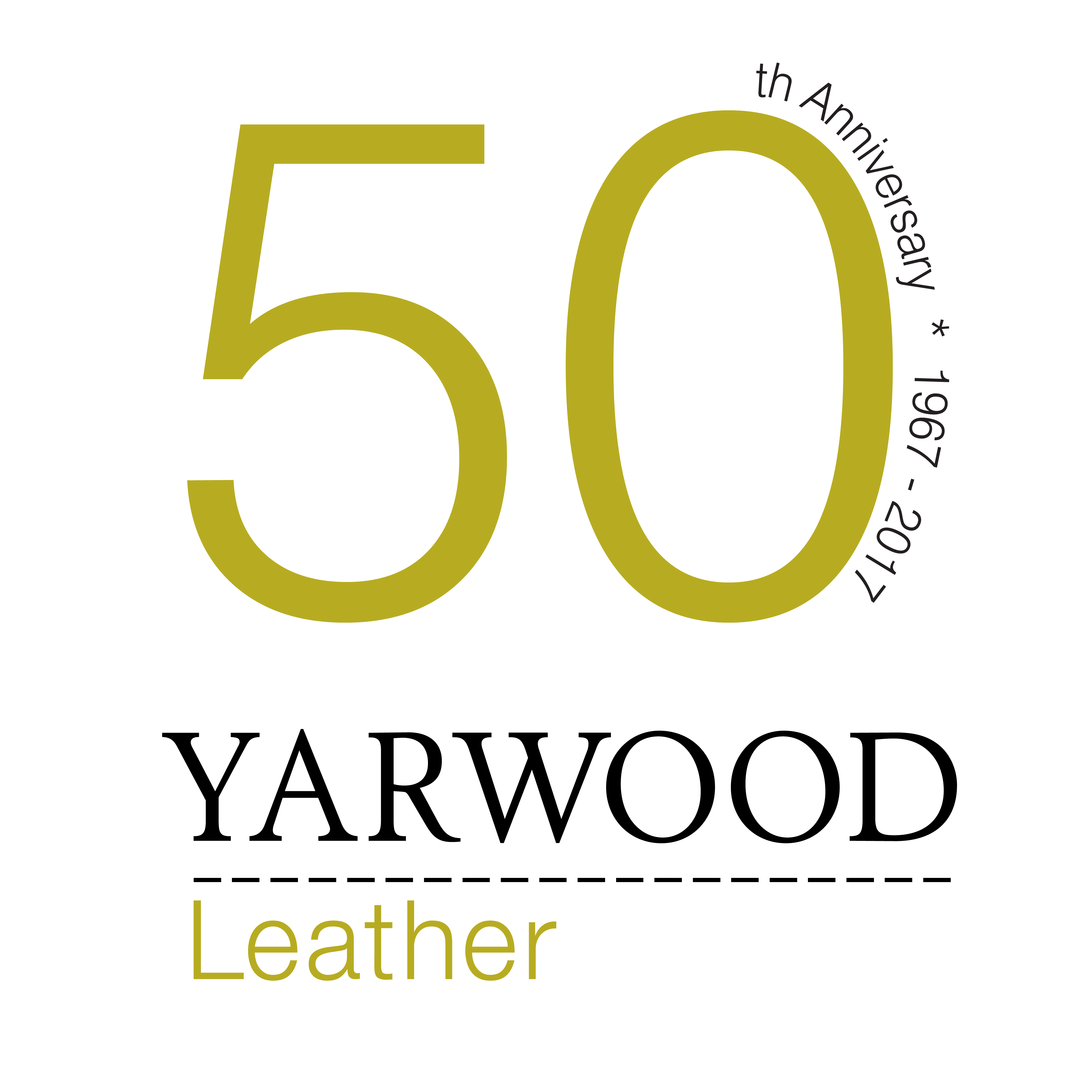1 March 2020
The A-Z of leather

The leather industry is extremely specialised, turning a natural by-product into a beautiful finished product which is long lasting. Due to this there are unique terms, here is a quick A-Z guide to some of the most common leather terminology.
Our team are always happy to help and answer any questions you may have, so please get in touch
Aniline Dyed
Leather that has been dyed by immersion in a dyebath and has not received any coating of pigmented finish.
Antique Grain
A surface pattern of markings or creases, usually irregular, in which the hollows are often given a contrasting colour to produce a two-tone or two-colour effect. The creases are produced by embossing,boarding or other similar means.
Antique Leather
Leather that has two dye layers, allowing one to be washed off or rubbed off (see rub-off and wash-off) to give an aged or antique look.
Buffed Leather
Leather manufactured by removing minor blemishes from the grain layer by an abrasive or bladed cylinder or, less generally by hand. In the case of upholstery leather the buffing process is invariably carried out by machine though it is sometimes incorrectly described as “hand buffed”.
Butcher Cuts
Damage to hides caused by improper removal of flesh / detritus from the animal. Damage is usually in the form of cuts or furrows on the flesh side, sometimes called flay damage.
Butt
The part of the hide after the bellies and shoulders have been removed.
Chrome Tanned
Leather tanned either solely with chromium salts or with chromium salts together with quite small amounts of some other tanning agent used merely to assist the chrome tanning process, and not in sufficient amount to alter the essential chrome tanned character of the leather.
Cigarette & Match Test
Test that forms part of BS 7176, the resistance to ignition of upholstered furniture. This particular section deals with the resistance to ignition of leather to a smoldering cigarette and simulated match.
Conditioning
The process where the temperature and humidity are regulated prior to testing. The requirements are that the temperature must be 23oC plus or minus 2oC and 50% Relative Humidity, plus or minus 5%. These are set in accordance with BS 3144.
Corrected Grain Leather
Leather from which the grain layer has been partially removed by buffing to a depth governed by the condition of the raw material and upon which a new surface has been built by various finishes.
Crib
An open structure wooden crate, whose size determines the nature of various iginition sources, for testing differing degrees of fire retardency.
Crib 5
The term given to a composite flammability test, often involving leather or other surface materials. A crib (see above) of size “5” is used in BS5852:2006 and leather that passes this test is often referred to as “crib5” leather.
Crust
Sometimes used as an adjectival noun, “in the crust”, to describe leather that has been dyed and dried, but not finished.
Embossed
Raised pattern either imitating the pattern of some animal, or giving a different pattern to the grain, quite unrelated to a natural grain pattern.
Finish
The final surface coating of the leather.
– The surface coating applied to a leather.
– The final process or processes in the manufacture of dressed leather.
– The final appearance of the leather, e.g bright, matt and velvet.
Finishing
The final process or processes in the manufacture of dressed leather.
Flaying
Damage to hides caused by improper removal of flesh / detritus from the animal. Damage is usually in the form of cuts or furrows on the flesh side, sometimes called flay damage.
Flexing Endurance
A measure of how the finish of a piece of leather will behave over time, with respect to the surface layer cracking.
Full Grain
Leather bearing the original grain surface of the skin and with none of the surface removed by buffing or splitting. In contrast see “corrected grain”.
Grain
The outer or hair side of a hide or skin, which is the pattern characterized by the pores that are peculiar to the animal concerned. They are visible on the outer surface of a hide or skin after the hair or wool and epidermal tissue have been removed. Also used as an adjective referring to that side.
Grey Scale
A measure for assessing the change in colour in scales of grey. Used in the leather industry to determine the colour change when examining colour transference in rub-fastness testing.
Growth Marks
Rippling of the hide, usually found around the neck area, that are due to animal’s growth pattern. Associated marking on the hide or leather can be accentuated by the liming process.
Grub Hole
A hole through the hide caused by the penetration of the grub of the warble fly.
Handle
A word used to describe the feel, softness and texture of a piece of leather.
Hand Wash
A type of leather, where the pigment effect is made entirely by hand, ensuring each hide is unique.
Heat Release
An aviation composite test that measures the specific energy output of the composite as it is exposed to a flame source. The energy output is measured in KiloWatts and is typically needed for wall panels and interior components on commercial jetliners globally.
Hide
The pelt of a large animal, such as cow, horse, etc. Also sometimes used interchangeably with ‘skin’. The outer covering of a mature or fully grown large mammal e.g cattle, horse, camel, elephant and whale. Leather made from (a) that has not been split, or from the grain split of such hide.
Leather
Hide or skin which still retains its original fibrous structure more or less intact, and which has been treated so as to be imputrescible even after exposure to water. The hair or wool may or may not have been removed. Certain skins, similarly treated or dressed, and without the hair removed, are termed “fur”.
Looseness
A term given to leather where:
– The grain corium junction has broken down and the result is that the boundary has become very loosely joined.
– The grain layer has been allowed to relax, to emphasise that its area is bigger than the corium.
– Too much substance is removed from the corium during chemical processing early in the process of making the leather
Looseness gives an appearance of large wrinkles when it is distorted, the leather feels empty and almost bubbly.
Mineral Tanned
Leather that has been tanned with mineral salts such as aluminium(III), chromium(III) or zirconium(IV) salts.
Natural Characteristics
Characteristics in the hide or skin that occur naturally throughout the life cycle of the cow, examples include scars, scratches and growth marks.
Nubuck
Cattle hide leather buffed on the grain side to give a velvety surface that has a distinctive nap to its surface.
Raw Hide
A hide which has only been treated to preserve it prior to tanning.
Retannage
A modifying secondary tannage applied after intermediate operations following the primary tannage, either to even out the primary tannage or impart different properties to the leather.
Rub-Fastness
If something has a fastness to something, then it will not change its properties in its presence, e.g. something that is fast to rubbing or has good rub fastness, will not change colour easily when rubbed.
The resistance of a leather to the rubbing effect of a felt pad, either wet or dry, to simulate wear in use.
Rub-Off
A type of leather with a fugitive top coat that, once treated with the appropriate chemicals, moves and creates an antique effect. This effect must then be sealed with a lacquer to stop any further movement.
Splitting
The process of cutting leather into two or more layers.
Spue
Spueing is the term given when a component of the leather migrates to the surface. The two most common types are fatty spues and salt spues. Fatty spue looks like white fluffy clouds on the surface of the leather and disappears with localised heating because it is due to low melting point fatty acids. Salt spue can be removed with a damp cloth.
Staking
A process where finished leather is subjected to a pummelling type of mechanical stressing by a machine, to soften it.
Stucco
A polymer that is used to fill small cuts and scars. It comes in a putty type form that, when allowed to air dry, forms a dry but flexible filling.
Substance
The measure of the thickness of the leather.
Tanning
Processing whereby putrescible raw hides and skins are converted into leather.
Veins
Veins can show up on the flesh side of leather as branch marks. The cause is inadequate bleeding after the animal is killed or the selective degradation of the vein material by elastolytic enzymes, during the earlier stages of processing. The areas that used to contain a vein can become very loose, the leather is then said to be veiny. In extreme cases, the veins can show up in the grain layer.
Veslic Rub-Fastness Tester
A machine used to determine the rub-fastness of a piece of leather.
Wet-Blue Leather
Leather which has been chrome tanned, but has not been further processed and is sold in the wet condition.
Wrinkle
A permanent crease or furrow on the grain surface of a hide or leather, incapable of removal by rolling or plating.

